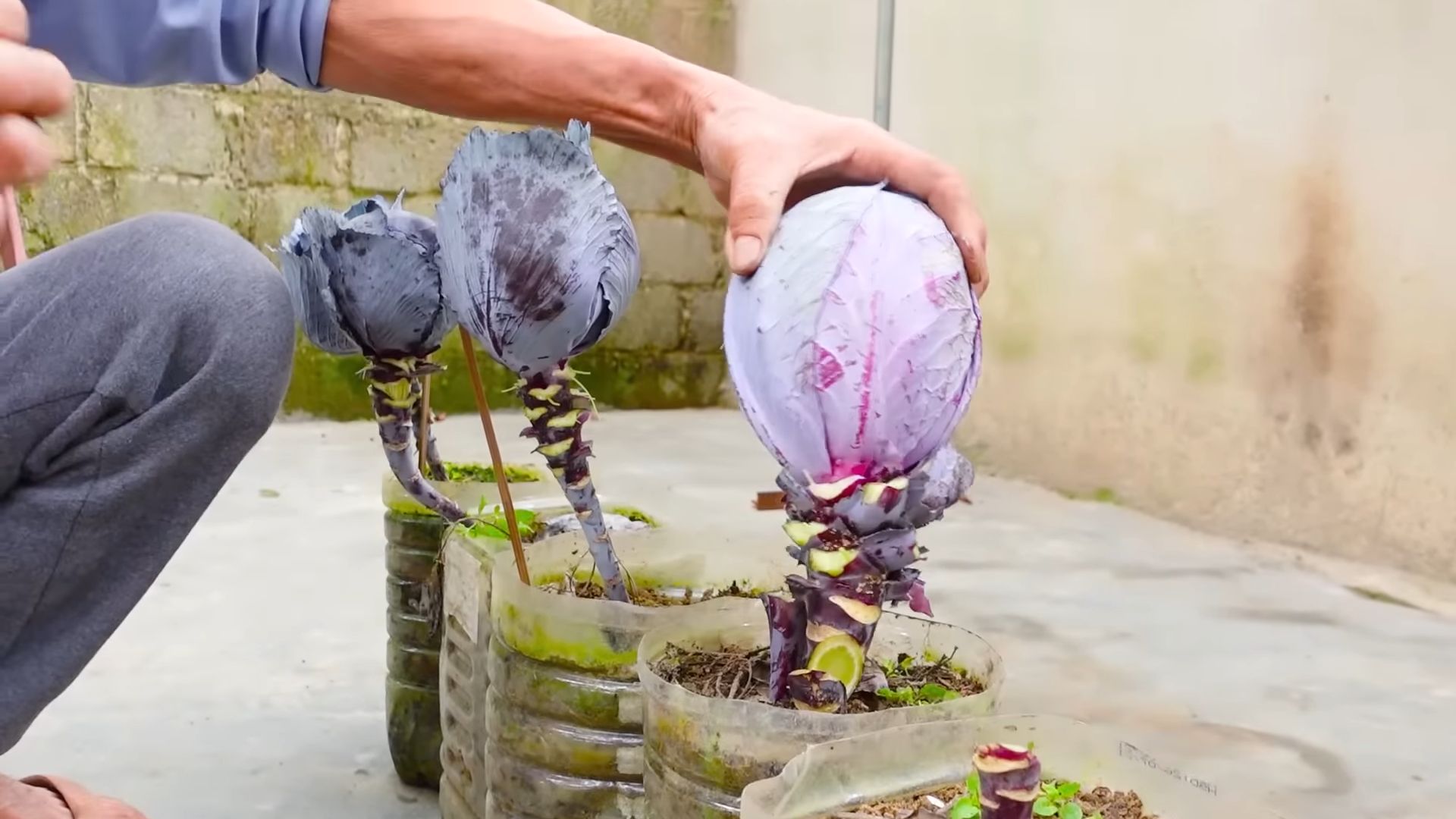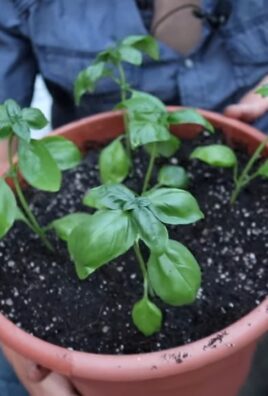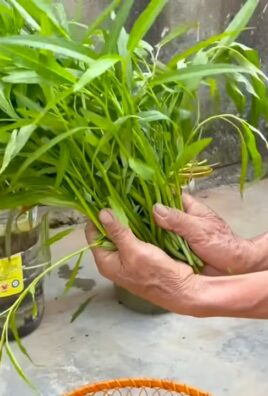Growing Purple Cabbage might seem intimidating, but trust me, it’s a rewarding experience that adds a vibrant splash of color and nutrition to your garden and your plate! Have you ever dreamt of harvesting your own jewel-toned heads of cabbage, ready to be transformed into delicious slaws, stir-fries, or even fermented delights? This DIY guide will unlock the secrets to successfully cultivating this beautiful vegetable, even if you’re a complete beginner.
Cabbage, in general, has a rich history, dating back thousands of years. Ancient Romans and Greeks prized it for its medicinal properties and culinary versatility. While green cabbage is a staple, growing purple cabbage offers a unique twist, both visually and nutritionally. The deep purple hue comes from anthocyanins, powerful antioxidants that are beneficial for your health.
Why should you bother with this DIY project? Well, store-bought purple cabbage can sometimes be expensive and lack the freshness of homegrown produce. Plus, there’s nothing quite like the satisfaction of nurturing a plant from seed to harvest. This guide will provide you with simple, step-by-step instructions and helpful tips to ensure your success. I’ll share my favorite tricks for choosing the right variety, preparing the soil, and protecting your precious plants from pests and diseases. Get ready to impress your friends and family with your gardening prowess and enjoy the delicious rewards of your labor!

Growing Gorgeous Purple Cabbage: A DIY Guide for Vibrant Veggies!
Okay, so you want to grow your own purple cabbage? Awesome! It’s easier than you might think, and the payoff – those beautiful, vibrant heads – is totally worth it. I’m going to walk you through everything you need to know, from seed to harvest. Let’s get started!
Choosing Your Purple Cabbage Variety
First things first, let’s talk about varieties. There are a few different types of purple cabbage, and each has its own characteristics. Here are a few popular choices:
* ‘Red Acre’: This is a classic, reliable variety. It produces medium-sized, round heads with a deep purple color. It’s also known for its good storage ability.
* ‘Ruby Perfection’: As the name suggests, this one’s a beauty! It has a slightly flattened shape and a rich, reddish-purple hue. It matures relatively quickly, which is a bonus.
* ‘Red Express’: If you’re looking for an early harvest, ‘Red Express’ is a great option. It produces smaller heads, but they’re ready to pick sooner than other varieties.
* ‘Scarlet O’Hara’: This variety is known for its excellent flavor and vibrant color. It’s a good choice for both fresh eating and cooking.
I personally love ‘Ruby Perfection’ because of its color and relatively quick maturity, but feel free to experiment and find the variety that works best for you!
Starting Your Seeds (or Buying Transplants)
You have two options here: starting your own seeds indoors or buying transplants from a local nursery. Starting from seed gives you more control and can be more cost-effective, but buying transplants is quicker and easier.
Starting Seeds Indoors:
If you’re going the seed route, here’s what you need to do:
1. Gather Your Supplies: You’ll need seed starting trays or small pots, seed starting mix (not regular potting soil!), purple cabbage seeds, a spray bottle, and a grow light (optional, but highly recommended).
2. Sow the Seeds: Fill your trays or pots with seed starting mix. Moisten the mix with the spray bottle – you want it damp, not soggy. Sow the seeds about ¼ inch deep, placing 2-3 seeds in each cell or pot.
3. Provide Light and Warmth: Cabbage seeds need light to germinate, so place your trays or pots under a grow light or in a sunny window. Keep the soil consistently moist. The ideal temperature for germination is around 65-75°F (18-24°C).
4. Thin the Seedlings: Once the seedlings emerge (usually in about 5-10 days), thin them to one strong seedling per cell or pot. Snip off the weaker seedlings at the soil line with scissors.
5. Harden Off the Seedlings: Before transplanting your seedlings outdoors, you need to “harden them off.” This means gradually exposing them to outdoor conditions over a period of about a week. Start by placing them outside in a sheltered spot for an hour or two each day, gradually increasing the amount of time they spend outdoors.
Buying Transplants:
If you’re buying transplants, make sure to choose healthy-looking plants with sturdy stems and no signs of pests or diseases.
Preparing Your Garden Bed
Purple cabbage needs a sunny spot with well-drained soil. Here’s how to prepare your garden bed:
1. Choose a Sunny Location: Cabbage needs at least 6 hours of sunlight per day.
2. Test Your Soil: A soil test will tell you the pH and nutrient levels of your soil. Cabbage prefers a slightly acidic soil pH of 6.0 to 7.0. You can buy a soil testing kit at most garden centers.
3. Amend the Soil: Based on your soil test results, amend the soil as needed. Add compost or well-rotted manure to improve drainage and fertility. Cabbage is a heavy feeder, so it needs plenty of nutrients. I like to add a balanced organic fertilizer as well.
4. Till or Dig the Soil: Loosen the soil to a depth of at least 12 inches. This will make it easier for the cabbage roots to grow.
5. Create Planting Rows: Create rows that are about 2-3 feet apart. This will give the cabbage plants enough room to grow.
Transplanting Your Cabbage
Now for the fun part – getting those cabbage plants into the ground!
1. Choose the Right Time: Transplant your cabbage seedlings or transplants outdoors after the last frost. The soil temperature should be at least 50°F (10°C).
2. Dig Holes: Dig holes that are slightly larger than the root balls of your seedlings or transplants. Space the holes about 18-24 inches apart within the rows.
3. Remove the Plants: Gently remove the seedlings or transplants from their containers. If the roots are pot-bound (tightly circling the pot), gently loosen them before planting.
4. Plant the Cabbage: Place the seedlings or transplants in the holes, making sure the top of the root ball is level with the soil surface.
5. Fill the Holes: Fill the holes with soil and gently firm the soil around the plants.
6. Water Thoroughly: Water the plants thoroughly after transplanting. This will help them settle in and establish their roots.
Caring for Your Purple Cabbage
Once your cabbage is in the ground, it’s important to provide it with the care it needs to thrive.
1. Watering: Cabbage needs consistent moisture, especially during hot, dry weather. Water deeply whenever the top inch of soil feels dry. Aim for about 1-1.5 inches of water per week.
2. Fertilizing: Cabbage is a heavy feeder, so you’ll need to fertilize it regularly. Apply a balanced organic fertilizer every 2-3 weeks. You can also side-dress the plants with compost or well-rotted manure.
3. Weeding: Keep the garden bed free of weeds. Weeds compete with cabbage for water and nutrients. Hand-pull weeds or use a hoe to cultivate the soil.
4. Mulching: Apply a layer of mulch around the cabbage plants. Mulch helps to retain moisture, suppress weeds, and regulate soil temperature. I like to use straw or shredded leaves.
5. Pest Control: Cabbage can be susceptible to a variety of pests, including cabbage worms, aphids, and flea beetles. Inspect your plants regularly for signs of pests. If you find pests, you can try hand-picking them off the plants or using an organic insecticide, such as neem oil or insecticidal soap.
6. Disease Prevention: Cabbage can also be susceptible to diseases, such as black rot and clubroot. To prevent diseases, choose disease-resistant varieties, practice crop rotation, and avoid overhead watering.
Harvesting Your Purple Cabbage
The moment you’ve been waiting for! Here’s how to harvest your purple cabbage:
1. Check for Maturity: Cabbage is ready to harvest when the heads are firm and solid. The size of the head will vary depending on the variety, but generally, you can harvest when the heads are about 6-8 inches in diameter.
2. Cut the Head: Use a sharp knife to cut the head from the stem. Leave a few outer leaves attached to the head.
3. Store the Cabbage: Store the cabbage in the refrigerator. It will keep for several weeks.
Troubleshooting Common Problems
Even with the best care, you might encounter some problems while growing purple cabbage. Here are a few common issues and how to deal with them:
* Cabbage Worms: These green caterpillars can devour cabbage leaves. Hand-pick them off the plants or use Bacillus thuringiensis (Bt), a natural insecticide.
* Aphids: These tiny insects suck sap from cabbage leaves. Spray them off with a strong stream of water or use insecticidal soap.
* Flea Beetles: These small beetles chew tiny holes in cabbage leaves. Cover the plants with row covers or use an organic insecticide.
* Black Rot: This bacterial disease causes black spots on cabbage leaves. Choose disease-resistant varieties and practice crop rotation.
* Clubroot: This fungal disease causes swollen roots and stunted growth. Amend the soil with lime to raise the pH and practice crop rotation.
Enjoying Your Harvest!
Congratulations! You’ve successfully grown your own purple cabbage. Now it’s time to enjoy the fruits (or rather, vegetables) of your labor. Purple cabbage is delicious raw in salads, coleslaw, and slaws. It’s also great cooked in stir-fries, soups, and stews. You can even pickle it!
I hope this guide has been helpful. Growing your own purple cabbage is a rewarding experience, and I encourage you to give it a try. Happy gardening

Conclusion
So, there you have it! Growing your own purple cabbage isn’t just a gardening project; it’s an investment in vibrant flavors, stunning visual appeal, and a healthier lifestyle. We’ve walked you through the process, from selecting the right seeds to harvesting your beautiful, homegrown heads. But why should you bother with all this effort when you can simply buy purple cabbage at the store?
The answer lies in the unparalleled freshness and flavor you simply can’t replicate with store-bought produce. Imagine the crisp, slightly sweet taste of a purple cabbage harvested just hours before it graces your table. Think of the satisfaction of knowing exactly where your food comes from and that it’s free from harmful pesticides and chemicals. And consider the sheer joy of watching a tiny seed transform into a magnificent, jewel-toned vegetable.
Beyond the superior taste and quality, growing your own purple cabbage offers a unique opportunity to experiment and personalize your culinary creations. Try different varieties to discover your favorite flavor profiles. Some varieties offer a milder, sweeter taste, while others have a more pronounced, peppery bite. You can also adjust your growing conditions to influence the color intensity of your cabbage. For a deeper, more vibrant purple, ensure your soil is slightly acidic.
Variations and Creative Uses: Don’t limit yourself to just the standard coleslaw or stir-fries. Purple cabbage is incredibly versatile and can be used in a wide range of dishes.
* Fermented Delights: Transform your harvest into delicious and probiotic-rich sauerkraut or kimchi. The vibrant color of the cabbage will add a beautiful visual element to your fermented creations.
* Pickled Perfection: Quick-pickled purple cabbage makes a fantastic topping for tacos, sandwiches, and salads. The tangy flavor and crunchy texture will elevate any dish.
* Roasted Goodness: Roasting purple cabbage brings out its natural sweetness and creates a caramelized, slightly smoky flavor. Toss it with olive oil, herbs, and spices for a simple yet satisfying side dish.
* Juicing Powerhouse: Add purple cabbage to your juicing routine for a boost of vitamins, minerals, and antioxidants. Its vibrant color indicates a high concentration of beneficial compounds.
Growing your own purple cabbage is also a fantastic way to connect with nature and learn about the fascinating process of plant growth. It’s a rewarding experience that can be enjoyed by gardeners of all skill levels. Even if you only have a small balcony or patio, you can still grow purple cabbage in containers.
The key takeaway here is that growing purple cabbage is more than just a gardening task; it’s a gateway to a healthier, more flavorful, and more fulfilling lifestyle. It’s an opportunity to connect with nature, experiment in the kitchen, and enjoy the fruits (or rather, vegetables) of your labor.
So, what are you waiting for? Grab some seeds, prepare your soil, and embark on your own purple cabbage growing adventure. We’re confident that you’ll be amazed by the results. And once you’ve harvested your beautiful, homegrown cabbage, we encourage you to share your experiences with us. Tell us about your favorite varieties, your creative culinary creations, and any tips or tricks you’ve learned along the way. Let’s build a community of purple cabbage enthusiasts and inspire others to discover the joys of growing their own food.
Don’t forget to document your journey and share photos of your thriving purple cabbage plants. Use the hashtag #HomegrownPurpleCabbage so we can all admire your success! We can’t wait to see what you create. Happy gardening!
Frequently Asked Questions (FAQ)
What is the best time of year to plant purple cabbage?
The ideal time to plant purple cabbage depends on your climate. In general, it’s best to plant purple cabbage in early spring for a summer harvest or in late summer for a fall/winter harvest. For spring planting, start seeds indoors 6-8 weeks before the last expected frost. For fall planting, direct sow seeds in the garden 2-3 months before the first expected frost. Check your local climate data for specific frost dates.
How much sunlight does purple cabbage need?
Purple cabbage requires at least 6 hours of direct sunlight per day to thrive. More sunlight will result in larger, more vibrant heads. If you’re growing purple cabbage in a container, make sure to place it in a sunny location. If you live in a particularly hot climate, some afternoon shade can be beneficial to prevent the leaves from scorching.
What type of soil is best for growing purple cabbage?
Purple cabbage prefers well-drained, fertile soil that is rich in organic matter. The ideal soil pH is between 6.0 and 7.0. Before planting, amend your soil with compost or well-rotted manure to improve its fertility and drainage. You can also add a slow-release fertilizer to provide your plants with the nutrients they need.
How often should I water purple cabbage?
Purple cabbage needs consistent moisture to grow properly. Water deeply and regularly, especially during dry periods. Aim to keep the soil consistently moist but not waterlogged. Mulching around your plants can help to retain moisture and suppress weeds. Check the soil moisture regularly by sticking your finger about an inch into the soil. If it feels dry, it’s time to water.
What are some common pests and diseases that affect purple cabbage?
Purple cabbage can be susceptible to several pests and diseases, including cabbage worms, aphids, flea beetles, and clubroot. To prevent pest problems, inspect your plants regularly and remove any pests you find. You can also use row covers to protect your plants from insects. To prevent diseases, practice crop rotation and avoid planting cabbage in the same location year after year. Ensure good air circulation around your plants and avoid overhead watering, which can promote fungal diseases.
How do I know when my purple cabbage is ready to harvest?
Purple cabbage is typically ready to harvest when the head is firm and solid. The size of the head will vary depending on the variety, but most varieties are ready to harvest when they reach about 6-8 inches in diameter. To harvest, use a sharp knife to cut the head from the stem. Leave a few outer leaves on the plant to protect the remaining stem.
Can I grow purple cabbage in containers?
Yes, you can successfully grow purple cabbage in containers. Choose a large container that is at least 12 inches in diameter and 12 inches deep. Use a well-draining potting mix and make sure the container has drainage holes. Water regularly and fertilize every few weeks. Place the container in a sunny location.
Why is my purple cabbage not turning purple?
Several factors can affect the color of purple cabbage. The most common reason is soil pH. Purple cabbage needs slightly acidic soil (pH 6.0-7.0) to develop its vibrant purple color. If your soil is too alkaline, the cabbage may remain green or only develop a faint purple hue. You can lower the soil pH by adding sulfur or peat moss to the soil. Other factors that can affect color include sunlight, temperature, and nutrient deficiencies.
How do I store purple cabbage after harvesting?
Purple cabbage can be stored in the refrigerator for several weeks. Wrap the head in plastic wrap or place it in a plastic bag to prevent it from drying out. You can also store purple cabbage in a root cellar or other cool, dark place.
Can I eat the outer leaves of purple cabbage?
Yes, the outer leaves of purple cabbage are edible, but they may be tougher and more fibrous than the inner leaves. Remove any damaged or discolored leaves before using them. The outer leaves are great for adding to soups, stews, or stir-fries.
What are the health benefits of eating purple cabbage?
Purple cabbage is a nutritional powerhouse, packed with vitamins, minerals, and antioxidants. It’s a good source of vitamin C, vitamin K, fiber, and anthocyanins, which are powerful antioxidants that give purple cabbage its vibrant color. Eating purple cabbage can help to boost your immune system, protect against chronic diseases, and improve your overall health.





Leave a Comment